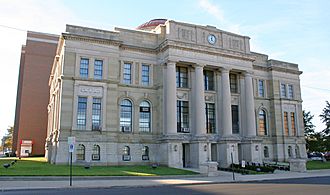Clark County Courthouse (Ohio) facts for kids
Quick facts for kids The Clark County Courthouse |
|
|---|---|

Clark County Courthouse in Springfield, Ohio
|
|
| General information | |
| Architectural style | Romanesque |
| Town or city | Springfield, Ohio |
| Country | United States |
| Coordinates | 39°55′37″N 83°48′15″W / 39.92694°N 83.80417°W |
| Construction started | 1918 |
| Completed | 1924 |
| Cost | $115,000 |
| Client | Clark County Commissioners |
| Design and construction | |
| Architect | William K. Schilling |
| Engineer | Builder: |
The Clark County Courthouse is a special building in Springfield, Ohio. It's where important legal decisions for Clark County are made. This building is the third courthouse built for the county. It even stands on the same spot as the second one!
Contents
The First Courthouse: A Slow Start
Building a Place for Justice
Clark County was created in 1818. At first, the court met in different places around Springfield. There wasn't enough money to build a proper courthouse.
In 1819, some citizens offered to help. They promised money to build a permanent courthouse. Construction began, but it took a long time. The building was supposed to be finished in 1820, but it wasn't ready until 1828.
What the First Courthouse Looked Like
The first courthouse was designed by Ambler & Fisher. It looked a bit like Ohio's first state capitol building. It was a square, two-story building made of red brick. It had three windows on each side with white frames and shutters.
The roof was high and sloped, with four tall chimneys. In the middle of the roof was a small tower called a cupola. This cupola had a dome on top, ending in a spire.
The Second Courthouse: A Grand Design and a Fiery End
A New Building for a Growing County
The first courthouse served the county for 50 years. But as the county grew, the building became too small. In 1878, the old courthouse was sold for just $50. It was then torn down to make way for a new, bigger courthouse.
The new courthouse was designed by Thomas J. Tolan & Son, Architects. It was built in a popular style called Second Empire.
Features of the Second Courthouse
This new building was made of limestone. The bottom part had rough, textured stones, while the upper parts were smooth. It was a two-story building with a special roof called a mansard roof. This roof had towers at each corner with windows sticking out.
The main entrance faced Columbia Street. It had a large tower with a tall spire and a four-sided clock. Steps led up to an arched entryway.
The Fire of 1918
Sadly, this grand courthouse caught fire on March 12, 1918. The fire destroyed the inside and most of the outside. Luckily, all the important court records were saved. The county had a smart plan to store them in a separate, safe place.
The Courthouse Today: A Mix of Old and New
Rebuilding After the Fire
The courthouse you see today was rebuilt after the 1918 fire. It was reconstructed between 1918 and 1924. The architect for this rebuilding project was William K. Schilling.
Some of the original exterior walls from the second courthouse were saved. They were used in the new design. This means the building is a mix of old and new parts.
Looking at the Outside
The ground floor still has the rough, textured stone from before the fire. The first and second floors have smooth stone blocks. The basement windows are small and arched, often in pairs.
The first floor has large arched windows. These are separated by tall, flat columns called pilasters, which look like Doric columns. The third floor has simple, rectangular windows without much decoration.
The large front tower, the grand stairs, and the mansard roof were lost in the fire. The main entrance was changed to face Limestone Street. Now, you can enter directly from the ground level. Large columns stand on each side of the entrance, holding up a projected roof.
Above the entrance, you can see the words "Clark County Court House" carved into the stone. A decorative railing sits above this, with a single clock face above the entrance. A low dome is in the center of the roof, but it's partly hidden.

